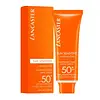What's inside
What's inside
 Key Ingredients
Key Ingredients

 Benefits
Benefits

 Concerns
Concerns

 Ingredients Side-by-side
Ingredients Side-by-side

Water
Skin ConditioningDicaprylyl Carbonate
EmollientOctocrylene
UV AbsorberGlycerin
HumectantTribehenin PEG-20 Esters
EmollientButyl Methoxydibenzoylmethane
UV AbsorberC12-15 Alkyl Benzoate
AntimicrobialAlcohol
AntimicrobialEthylhexyl Methoxycinnamate
UV AbsorberMethylene Bis-Benzotriazolyl Tetramethylbutylphenol
UV FilterDiethylhexyl Butamido Triazone
UV AbsorberMethyl Methacrylate Crosspolymer
Nylon-12
Bis-Ethylhexyloxyphenol Methoxyphenyl Triazine
Skin ConditioningPotassium Cetyl Phosphate
EmulsifyingTitanium Dioxide
Cosmetic Colorant1,2-Hexanediol
Skin ConditioningAcrylates Copolymer
Alumina
AbrasiveAluminum Hydroxide
EmollientAluminum Stearate
Cosmetic ColorantAscorbic Acid
AntioxidantAscorbyl Palmitate
AntioxidantBHT
AntioxidantBisabolol
MaskingCalcium Sodium Phosphosilicate
Caprylyl Glycol
EmollientCitric Acid
BufferingDecyl Glucoside
CleansingDimethylmethoxy Chromanol
AntioxidantDisodium EDTA
Gluconolactone
Skin ConditioningGossypium Hirsutum Extract
Skin ConditioningHippophae Rhamnoides Oil
EmollientJasminum Officinale Flower Extract
MaskingLinoleic Acid
CleansingLinolenic Acid
CleansingMauritia Flexuosa Fruit Oil
Skin ConditioningMica
Cosmetic ColorantPanthenol
Skin ConditioningPantolactone
HumectantPEG-8
HumectantPentylene Glycol
Skin ConditioningPropylene Glycol
HumectantRuby Powder
Skin ConditioningSodium Hydroxide
BufferingStearic Acid
CleansingSucrose
HumectantTapioca Starch
Tocopherol
AntioxidantXanthan Gum
EmulsifyingXanthophylls
Skin ConditioningChlorphenesin
AntimicrobialPhenoxyethanol
PreservativeSodium Benzoate
MaskingParfum
MaskingCI 77891
Cosmetic ColorantWater, Dicaprylyl Carbonate, Octocrylene, Glycerin, Tribehenin PEG-20 Esters, Butyl Methoxydibenzoylmethane, C12-15 Alkyl Benzoate, Alcohol, Ethylhexyl Methoxycinnamate, Methylene Bis-Benzotriazolyl Tetramethylbutylphenol, Diethylhexyl Butamido Triazone, Methyl Methacrylate Crosspolymer, Nylon-12, Bis-Ethylhexyloxyphenol Methoxyphenyl Triazine, Potassium Cetyl Phosphate, Titanium Dioxide, 1,2-Hexanediol, Acrylates Copolymer, Alumina, Aluminum Hydroxide, Aluminum Stearate, Ascorbic Acid, Ascorbyl Palmitate, BHT, Bisabolol, Calcium Sodium Phosphosilicate, Caprylyl Glycol, Citric Acid, Decyl Glucoside, Dimethylmethoxy Chromanol, Disodium EDTA, Gluconolactone, Gossypium Hirsutum Extract, Hippophae Rhamnoides Oil, Jasminum Officinale Flower Extract, Linoleic Acid, Linolenic Acid, Mauritia Flexuosa Fruit Oil, Mica, Panthenol, Pantolactone, PEG-8, Pentylene Glycol, Propylene Glycol, Ruby Powder, Sodium Hydroxide, Stearic Acid, Sucrose, Tapioca Starch, Tocopherol, Xanthan Gum, Xanthophylls, Chlorphenesin, Phenoxyethanol, Sodium Benzoate, Parfum, CI 77891
Butyl Methoxydibenzoylmethane 3%
UV AbsorberHomosalate 10%
Skin ConditioningEthylhexyl Salicylate 5%
UV AbsorberOctocrylene 8%
UV AbsorberWater
Skin ConditioningBeeswax
Emulsion StabilisingAloe Barbadensis Leaf Juice
Skin ConditioningIsopropyl Palmitate
EmollientCetearyl Alcohol
EmollientCyclopentasiloxane
EmollientCyclohexasiloxane
EmollientCeteareth-20
CleansingHydroxyacetophenone
AntioxidantCarbomer
Emulsion StabilisingBenzyl Alcohol
PerfumingSaccharide Isomerate
HumectantPhenoxyethanol
PreservativeSodium Stearoyl Glutamate
CleansingTriethanolamine
BufferingTocopheryl Acetate
AntioxidantSodium Chloride
MaskingCitric Acid
BufferingButyl Methoxydibenzoylmethane 3%, Homosalate 10%, Ethylhexyl Salicylate 5%, Octocrylene 8%, Water, Beeswax, Aloe Barbadensis Leaf Juice, Isopropyl Palmitate, Cetearyl Alcohol, Cyclopentasiloxane, Cyclohexasiloxane, Ceteareth-20, Hydroxyacetophenone, Carbomer, Benzyl Alcohol, Saccharide Isomerate, Phenoxyethanol, Sodium Stearoyl Glutamate, Triethanolamine, Tocopheryl Acetate, Sodium Chloride, Citric Acid
 Reviews
Reviews

Ingredients Explained
These ingredients are found in both products.
Ingredients higher up in an ingredient list are typically present in a larger amount.
Also known as Avobenzone, this ingredient is a chemical sunscreen filter that provides protection in the UV-A range.
Avobenzone is globally approved and is the most commonly used UV-A filter in the world.
Studies have found that avobenzone becomes ineffective when exposed to UV light (it is not photostable; meaning that it breaks down in sunlight). Because of this, formulations that include avobenzone will usually contain stabilizers such as octocrylene.
However, some modern formulations (looking at you, EU!) are able to stabilize avobenzone by coating the molecules.
Avobenzone does not protect against the UV-B range, so it's important to check that the sunscreen you're using contains other UV filters that do!
The highest concentration of avobenzone permitted is 3% in the US, and 5% in the EU.
Learn more about Butyl MethoxydibenzoylmethaneCitric Acid is an alpha hydroxy acid (AHA) naturally found in citrus fruits like oranges, lemons, and limes.
Like other AHAs, citric acid can exfoliate skin by breaking down the bonds that hold dead skin cells together. This helps reveal smoother and brighter skin underneath.
However, this exfoliating effect only happens at high concentrations (20%) which can be hard to find in cosmetic products.
Due to this, citric acid is usually included in small amounts as a pH adjuster. This helps keep products slightly more acidic and compatible with skin's natural pH.
In skincare formulas, citric acid can:
While it can provide some skin benefits, research shows lactic acid and glycolic acid are generally more effective and less irritating exfoliants.
Most citric acid used in skincare today is made by fermenting sugars (usually from molasses). This synthetic version is identical to the natural citrus form but easier to stabilize and use in formulations.
Read more about some other popular AHA's here:
Learn more about Citric AcidOctocrylene protects skin from sun damage. It absorbs UV-B with peak absorption of 304 nm. It is a common sunscreen ingredient and often paired with avobenzone, a UVA filter. This is because octocrylene stabilizes other sunscreen ingredients by protecting them from degradation when exposed to sunlight. Octocrylene is a photostable ingredient and loses about 10% of SPF in 95 minutes.
Octocrylene also acts as an emollient, meaning it helps skin retain moisture and softens skin. It is oil-soluble and hydrophobic, enhancing water-resistant properties in a product.
Those who are using ketoprofen, a topical anti-inflammatory drug, may experience an allergic reaction when using octocrylene. It is best to speak with a healthcare professional about using sunscreens with octocrylene.
The EU allows a maximum of these concentrations:
Learn more about OctocrylenePhenoxyethanol is a preservative that has germicide, antimicrobial, and aromatic properties. Studies show that phenoxyethanol can prevent microbial growth. By itself, it has a scent that is similar to that of a rose.
It's often used in formulations along with Caprylyl Glycol to preserve the shelf life of products.
Water. It's the most common cosmetic ingredient of all. You'll usually see it at the top of ingredient lists, meaning that it makes up the largest part of the product.
So why is it so popular? Water most often acts as a solvent - this means that it helps dissolve other ingredients into the formulation.
You'll also recognize water as that liquid we all need to stay alive. If you see this, drink a glass of water. Stay hydrated!
Learn more about Water